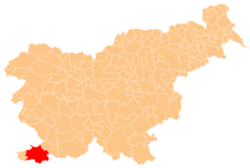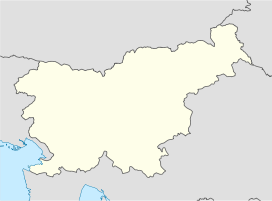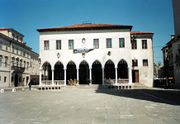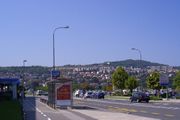Koper
| Koper Capodistria Kopar |
|||
|---|---|---|---|
| — Town and Municipality — | |||
|
|
|||
|
|||
 |
|||
 Koper
|
|||
| Coordinates: | |||
| Country | |||
| Region | Primorska | ||
| Municipality | Koper | ||
| Government | |||
| - Mayor | Boris Popovič | ||
| Area | |||
| - Total | 311.2 km2 (120.2 sq mi) | ||
| Population (2002)[1] | |||
| - Total | 47,539 | ||
| - Density | 152.8/km2 (395.6/sq mi) | ||
| Time zone | CET (UTC+01) | ||
| - Summer (DST) | CEST (UTC+02) | ||
| Source: Statistical Office of the Republic of Slovenia, census of 2002. | |||
Koper (pronunciation) (Italian: Capodistria; Croatian: Kopar) is a coastal town and municipality and the largest commercial port in Slovenia, on the coast of the Adriatic Sea.[2] The town has a population of 23,726 and is officially bilingual, with both Slovene and Italian as official languages. Sights in Koper include the 15th-century Praetorian Palace and Loggia in Venetian Gothic style, the 12th century Carmine Rotunda church, and the Cathedral of St Nazarius with its 14th century tower.
Koper is also one of the main road entry points into Slovenia from Italy, which lies to the north of the municipality. The main motorway crossing is at Spodnje Škofije to the north of Koper city; the motorway continues into Rabuiese and Trieste. Koper also has a rail connection with the capital city, Ljubljana. On the coast, there is a crossing at Lazaret into Lazaretto in Muggia comune in Trieste province. The Italian border crossing is known as San Bartolomeo. Italian used to be the main language in the city, spoken by 92% of the population in 1900, but this number decreased sharply after Koper was incorporated into Yugoslavia in 1954 and many of the Italian population left; it is now mainly a second language used by the majority Slovenes.
Contents |
History



Koper rose from an ancient settlement built on an island in the southeastern part of the Gulf of Koper in the northern Adriatic. In the time of Ancient Greece, the town was known as Aegida, later it became known by its Latin names Capris, Caprea, Capre or Caprista, from which the modern Italian and Slovenian name stems.
In 568, Roman citizens of nearby Tergeste (modern Trieste) fled to Capris due to an invasion of the Lombards. In honour of the Byzantine emperor Justinian II, the town was renamed to Justinopolis. Later, Justinople was under both Lombard and Frankish rule and was shortly occupied by Avars in 8th century.
Since the 8th century, possibly even since the 6th century, Koper was the seat of a diocese. One of Koper's bishops was the Lutheran reformer Pier Paolo Vergerio. In 1828, it was merged into the diocese of Trieste.
Trade between Koper and Venice had been registered since 932. In the war between Venice and Germany (Holy Roman Empire), Koper was on the German side, and was in result awarded with town rights, granted in 1035 by the emperor Conrad II. From 1232, Koper was under the Patriarch of Aquileia, and in 1278 it joined the Republic of Venice. It was at this time that the city walls and towers were partly demolished.[3]
In 1420, the Patriarch of Aquileia ceded his remaining possessions in Istria to the Republic, consolidating Venetian power in Koper.[4]
Koper grew to become the capital of Venetian Istria and was renamed Caput Histriae, "head of Istria" (from which stems its modern Italian name, Capodistria).
The sixteenth century saw the population of Koper fall drastically, from its high of between 10,000 and 12,000 inhabitants, due to repeated plague epidemics.[5] When Trieste became a free port in 1719, Koper lost its monopoly on trade, and its importance diminished further.[6]
According the census of the year 1900, 7205 Italian, 391 Slovenian, 167 Croatian and 67 German inhabitants lived in Koper.
Assigned to Italy after World War I, at the end of World War II it was part of the Zone B of the Free Territory of Trieste, controlled by Yugoslavia. Most of the Italian inhabitants left the city by 1954, when the Free Territory of Trieste formally ceased to exist and Zone B became part of Socialist Federal Republic of Yugoslavia. In 1977, the Roman Catholic Diocese of Koper was separated from the Diocese of Trieste.
With Slovenian independence in 1991 Koper became the only commercial port in Slovenia. The University of Primorska is based in the town.
Population
The municipality has 47,539 inhabitants. Of these, 23,385 (49.19%) are male; 24,154 (50.81%) are female.
- Population by mother language, census 2002[7]
- Slovene 35,246 (74.14%)
- Croatian 3,824 (8.04%)
- Serbo-Croatian 1,911 (4.02%)
- Bosnian 1,311 (2.76%)
- Serbian 1,268 (2.67%)
- Italian 1,059 (2.23%)
- Albanian 240 (0.50%)
- Macedonian 227 (0.48%)
- Others and Unknown 2453 (5.16%)
- Total 47,539
Prominent citizens
- Zvest Apollonio (1935–2009), painter
- Gian Rinaldo Carli (1720–1795), man of letters
- Vittore Carpaccio (c. 1460 - c. 1525), painter. Born in Venice, lived in Koper (then Capodistria)
- Boris Cavazza (1939 - ), actor
- Aldo Cherini (1919 - ), historian and writer[8]
- Giorgio Cobolli, Italian gold medal in the Second World War[9]
- Lucija Čok, linguist, politician
- Zlatko Dedič (1984 - ), football player
- Lorella Flego (1974 - ), TV entertainer
- Rudolf Golouh (1887–1982), politician and author
- Aurelio Juri (1949 - ), politician
- Franco Juri (1956 - ), politician, musician
- Ioannis Kapodistrias (1776–1831), Greek patriot and first governor of the Greek state(1828–1831) his family hailed originally from Koper/Capodistria
- Andreja Klepač (1986 - ), professional tennis player
- Tinkara Kovač (1978 - ), singer
- Bruno Maier (1922–2001), writer and literary critic[10]
- Matjaž Markič (1983 - ), swimmer
- Davor Mizerit (1981 - ), rower
- Igor Pribac (1958 - ), philosopher
- Pier Antonio Quarantotti Gambini (1910–1965), journalist and writer. Born in Pazin (then Pisino), lived in Koper (then Capodistria)[11][12]
- Tomaž Šalamun (1941 - ), poet
- Santorio Santorio (1561–1636), medical scientist
- Nazario Sauro (1880–1916), Italian irredentist and sailor
- Spartaco Schergat (1920–1996), military frogman, sank the English battleship Queen Elizabeth in 1941. Italian gold medal in the Second World War[13]
- Francesco Trevisani (1656–1746), painter
- Pier Paolo Vergerio the Elder (1370 - 1444/1445), humanist, statesman and canonist[14]
- Pier Paolo Vergerio the Young (1498–1565), man of Church
- Captain Antonio Zetto, traveller, Globe Trotting: A Ten Years Walk 1922 - 1932
- Vittorio Italico Zupelli (1859–1945), general, minister
International relations
Twin towns — Sister cities
Koper is twinned with:
References
Notes
- ↑ Statistical Office of the Republic of Slovenia, census of 2002
- ↑ Entry for Koper in the Lonely Planet Guide to Slovenia
- ↑ "A Historical Outline Of Istria". Zrs-kp.si. http://www.zrs-kp.si/zrs/zgodovina/e-middle.html. Retrieved 2010-03-27.
- ↑ Schutte, Anne Jacobson: Pier Paolo Vergerio: the making of an Italian reformer; p23
- ↑ Schutte, Anne Jacobson; p24
- ↑ "History of Koper - Lonely Planet Travel Information". Lonelyplanet.com. http://www.lonelyplanet.com/slovenia/karst-and-coast/koper/history. Retrieved 2010-03-27.
- ↑ Slovenian Statistics Office site, results of the 2002 census
- ↑ Page in Italian about Aldo Cherini
- ↑ Brief article in Italian from Corriere della Sera: Lutto, muore Giorgio Cobolli eroe della Guerra d'Africa (George Cobolli, hero of African War, is dead)
- ↑ Page on Bruno Maier in Italian
- ↑ [1]
- ↑ 'http://www.retecivica.trieste.it/ipe_archivio/agm/ts.pdf
- ↑ Article in Italian about the sinking of the battleship Queen Elizabeth.
- ↑ Press on Vergerius, Petrus Paulus
- ↑ "AllCorfu.Com: Corfu's Twin Cities". allcorfu.com. http://www.allcorfu.com/in-trivia.html. Retrieved 25 February 2010.
- ↑ 16.0 16.1 "Comune di Ferrara - Portale Telematico Estense". Ferrara.comune.fe.it. http://ferrara.comune.fe.it/. Retrieved 2010-03-27.
- ↑ "Sito ufficiale del Comune di Muggia". Comune.muggia.ts.it. http://www.comune.muggia.ts.it/. Retrieved 2010-03-27.
- ↑ "Sito Web del Comune di S.Dorligo della Valle - Dolina (TS)". Comune.san-dorligo-della-valle.ts.it. http://www.comune.san-dorligo-della-valle.ts.it/. Retrieved 2010-03-27.
- ↑ [2]
- ↑ "Welcome to JiuJiang". Jiujiang.gov.cn. http://www.jiujiang.gov.cn/English/. Retrieved 2010-02-25.
- ↑ http://72.30.186.56/search/cache?ei=UTF-8&p=Saint+John%27s+sister+cities&type=yahoo_avg_hs2-tb-web_chrome_us&fr=yhs-avg-chrome&u=clevelandslovenian.com/&w=saint+john%27s+john+sister+cities&d=dDjhxhlMTA7T&icp=1&.intl=us
External links
- Official website in English
- Port of Koper (in Slovene)
- University of Primorska (in Slovene)
- Aerial view of Koper
- Students' Association of Koper (KŠOK)
- Panoramas of Koper and surrounding area
- Old pictures of Koper/Capodistria
|
|||||||||||||
|
||||||||


